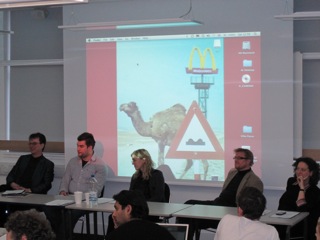Very difficult, when you’re running a conference, to properly take it in when the moment arrives, so these notes on the third ¡Documentary Now! are not your normal conference report. ¡Documentary Now! was initiated in 2007 by Mike Wayne, of Brunel University. The following year, while Mike was away on research in Venezuela, Alisa Lebow (also of Brunel) and myself, now at Roehampton, decided we should try and keep it going, and succeeded in raising funds from our respective institutions for the second edition. Following Mike’s initiative, we wanted to keep it free and centrally located, and thanks to Ian Christie, we were able to hold it in the splendid new cinema in Birkbeck’s Gordon Square building. For this third edition we managed to repeat the funding trick, and also received generous assistance from Brian Winston, the Lincoln Chair of Communications. We shifted from November to January, and benefited from the best of conference assistants, Holly Giesman, a PhD candidate in documentary at Roehampton. Many thanks to one and all! And thus we gathered last Friday afternoon, the snow and ice and slush of the preceding week finally gone, and although very wet and no sign of the sun, at least a wee bit warmer.
The biggest difficulty we’d had was the rich response we received to the call for papers—more than last time, and twice as many as space and time would permit. We were struck by their range, and the number that came from abroad—selection wasn’t easy and apologies to those we had to leave out. But I’m happy to say, the result was the best attended and most international edition to date. Panelists came from Holland and Spain, Canada and the USA. Given the international make-up of the postgraduate student community in London, it felt even more international—there were people of at least a dozen different nationalities among the more than one hundred conference-goers. (This is the beneficent side of London’s metropolitan attraction—not the financial concentration a mile away, but the cultural intercourse of its world city cosmopolitanism.)
This in turn meant that we heard presentations on documentary in China, India, Latin America and Europe, we heard about work being undertaken in South Africa and the Caribbean, and about Mexican migrant video culture, but very little from the USA. Even if large regions of the world, like the Middle East or Australia, were missing, the effect was intriguing, because it also demoted the superpower of cinema (and of geopolitics), and thus, instead of the usual perspective which always reproduces the hubris of empire, it becomes possible to re-envision the cultural impact of globalisation from a decentred position.
Judging by the feedback in the pub at the end of the day, the conference was a success. At any rate, it managed to create a suggestive dialogue between scholars and practitioners, which many people commented on, a small space where you could be both without feeling a freak, and where creativity and analysis could encounter each other and find out about current investigations alongside the cutting-edge of digital production techniques. A PhD student lamented that there had been no ¡Documentary Now! when she was doing her MA, but this time there were MA students from several places, as well as doctoral researchers in both practice and theory, and a number of unattached free spirits. (Very interesting to observe their mixed provenance, some of them coming from other disciplines, which reflects another feature of digital culture and the resurgence of documentary: the way it draws people in from different backgrounds and breaks down barriers between discourses and fields.)
There was universal praise for the film we saw in the opening plenary, the Bolivian short La Chirola, presented by its director, Diego Mondaca. Made as his graduation work for the international film school in Cuba, the EICTV, with an international crew of fellow students, this was the UK premiere of a film much garlanded with festival awards in Europe and Latin America. ‘Chirola’ is Bolivian slang for jail. The portrait of a former guerrilla, drug addict and prison inmate named Pedro Cajías, the film is a moving meditation on the paradoxes of freedom, and as Variety would say, visually superior.
There was also lively interest in our closing keynote, in which media artist Florian Thalhofer from Berlin presented the latest version of a piece of software he invented for interactive documentary, or what he calls database films, for streaming over the web (so the first thing to do is visit their web site and look at the numerous examples by people experimenting with it). The Korsakow system is an open source software programme which has now reached version 5, for authoring non-linear narratives, something people have been dreaming about for years. (I think of Julio Cortázar’s novel Rayuela (Hopscotch), and even more of the aleatory composers of the post-war avant garde, the followers of Cage in America and Boulez in Europe, and of Umberto Eco’s classic theoretical account of the aesthetics of The Open Work.) Korsakov, with its SNUs (single narrative units) and POCs (points of contact), may well have discovered the trick of how to do this deftly with multimedia, combining ease of use with huge potential. At any rate, I’m eager to start experimenting with it myself as soon as I can.




(The photos were taken in the seminar rooms, not the cinema.)

5 Responses to ¡Documentary Now! Again